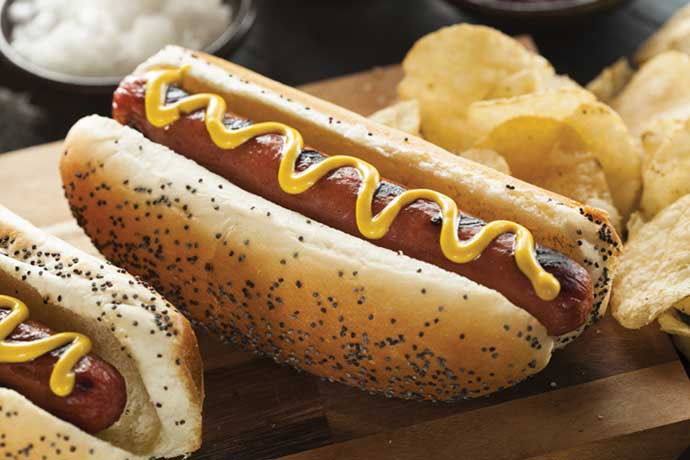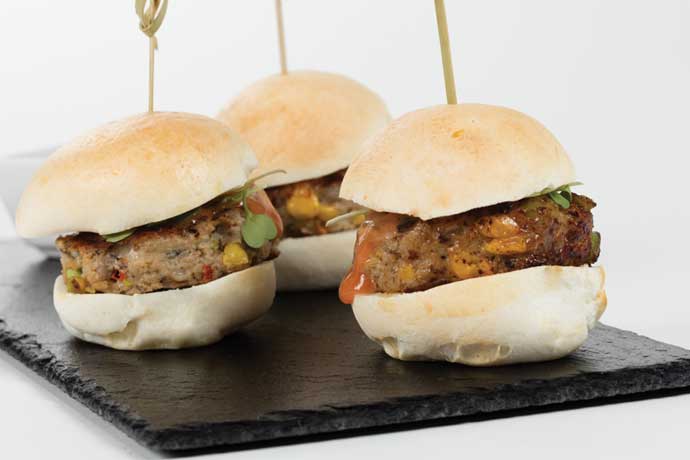What Is the Water Content of Raw Beef
Plump hot dog. Delicious turkey. Tender pot roast. Keeping meat and poultry juicy takes effort, but it does not need to be stressful for the home melt or chef. Processors can improve the h2o-property capacity (WHC) of animal protein through careful selection of raw materials – the meat and poultry – every bit well equally the improver of ingredients that assist with improving water retention earlier, during and later cooking.
Generally h2o
Meat and poultry, surprisingly, is generally equanimous of naturally occurring water. It is the water content that makes cooked muscle palatable.
On boilerplate, lean meat and poultry musculus at rigor is 75 percentage h2o, with some variation by species, muscle cutting, flavour and pH of the meat, according to the US Dept. of Agronomics. While being a full-bodied source of h2o, meat and poultry is typically consumed for its protein content, which is about xx per centum. The remaining 5 per centum is mostly fat, with miniscule amounts of carbohydrates, vitamins and minerals.
There's also intramuscular fat, which impacts total fatty content of untrimmed and os-in cuts, and basis and comminuted products. Fat contributes to juiciness, as well as overall flavour; however, with dietary recommendations guiding consumers to limit saturated fat intake, which is the primary fatty found in meat and poultry, consumers increasingly are choosing leaner cuts.
This makes h2o content even more important, every bit moisture content of packaged meat and poultry –raw whole muscle, uncooked footing, and candy/formed products, such as deli meats, nuggets, meatballs and sausages – directly influences eating quality and texture. That makes binding and retaining inherent moisture, as well as adding moisture during processing, a disquisitional product conception consideration.
H2o-holding capacity

Most of the water in musculus is held within the structure of the muscle itself, either inside the myofibrils (long protein strands) or between the myofibrils and other cell parts. One time harvested, some of the proteins often lose their grip, or water-binding power. This is because after slaughter, the glycogen in muscle is converted into lactic acid. This causes the pH of a live animal, which is 6.8 to vii.three, to drib to 5.4 to five.8. The pH impacts protein structure, which in turn influences its functionality. The higher the pH, the greater the protein'due south ability to bind moisture.
Further, there is a correlation between the quality of the muscle in the live animal and the amount of moisture lost in prepared meat and poultry products. Food manufacturers must rely on meat and poultry processors to provide quality raw textile, as WHC varies with animal genetics, pre-slaughter stress and postmortem treatments, among other variables.
Poor WHC of meat and poultry results in low cook yields due to high drip and purge loss, oft along with a dry out, rigid, chewy cooked product. 1 way to improve WHC is to increase postmortem pH upwardly to near half dozen. This can exist accomplished through the add-on of functional ingredients, as well as environmental considerations. Even something as uncomplicated equally the pH of factory water may brand a difference.
Loftier pressure level pasteurization (HPP) is emerging as one style to improve WHC in raw meat and poultry. This non-thermal cold processing engineering is all-time known for its ability to destroy spoilage and pathogenic microorganisms. Diverse studies show that this non-invasive process induces protein modifications that may event in product texture and h2o retention improvements, including higher cook yields and reduced purge.
On the ingredient side, there are various ingredients for meat and poultry manufacturers to use to bind moisture – inherent juices or added water – and lock it in the protein matrix. There are basically two categories based on functionality. There are the protein modifiers, with the most common existence phosphates, and the humectants, which hold h2o and subsequently thicken or gel within the meat structure.
Depending on the product, the 2 may be used together for all-time results. Application varies by product form.

With bone-in or boneless whole-muscle products, for case, moisture is added in the form of a brine or marinade. This can exist via immersion, injection or vacuum tumbling, or a combination. Immersion is the original approach to brining or marinating. As the name suggests, the process involves submerging the muscle into a solution, and over time, the ingredients penetrate the muscle through diffusion. Most manufacturers prefer the other two processes, equally they are more reliable for even distribution of h2o-binding ingredients.
Injection, for example, involves the use of inserting needles deep into the muscle. The needles and so inject the solution, where information technology has a better chance of spreading throughout. Vacuum tumbling involves massaging, which tenderizes the protein, and spinning the musculus with the brine or marinade, followed by vacuum to seal in the added solution.
Beefiness is the least likely to be enhanced, because of its inherently high fat content, which contributes to juiciness. Many poultry and pork formats, on the other paw, are often enhanced.
Regardless of protein source, ground and formed products, including balls, links and patties, are also commonly enhanced. The water may exist added straight to emulsified and formed products by mixing it into the ground-meat matrix. These products may be sold raw or fully cooked.
Most fully cooked meats, such equally heat-and-serve entrees, besides equally fix-to-swallow products like deli meats, hot dogs and sausages will contain added moisture. This includes hams, which have specific labeling guidelines in terms of added water.
That's because water is an integral part of the curing procedure, which turns whole muscle pork into ready-to-consume ham. In the US, ham must follow poly peptide fat-free (PFF) regulations stipulating that a production needs to contain at least 20.5 percentage protein, later on fatty removal, to exist labeled simply every bit ham. In that location are 3 other categories. "Ham with natural juices" must comprise at least xviii.5 percent protein, while "ham h2o added" is at least 17 percent protein. There's also "ham and water product," which has a PFF of less than 17 percent. These ham products must declare the percentage of added nonmeat ingredients – water, binders, etc. – on labels.
Regardless of application, if water is added, it must exist alleged on the ingredient statement at the position it appears as a percentage of the formulation. Further, there are legal limits that vary by product, ranging from equally little as 3 percent in fresh meats to more than xl percent in highly enhanced hams. These limits exist to prevent consumer deception.
Protein modifiers
The most mutual protein modifiers are food-course phosphates. These are derived from the element phosphorus, which is naturally establish in many phosphate minerals. Phosphates assume many forms and are recognized as protein modifiers because of their ability to raise pH. This in plow opens up the protein structure in meat and poultry, increasing the number of binding sites for water, and thus increasing WHC.
Phosphates are able to shift pH due to their buffering chapters, with brusk-concatenation phosphates generally having the greatest impact. Phosphates besides serve other functions in meat and poultry, including preserving colour, assisting with freeze/thaw stability, maintaining season and preventing rancidity of fat forth with the development of warmed-over-flavor when a production is reheated. Thus, processors often use blends of phosphates designed for specific applications. The usage level for sodium and potassium phosphates in meat and poultry products is limited to 0.5 percent.
Calculation humectants
A humectant attracts and retains moisture in a organisation. In meat and poultry, it absorbs and binds water. Diverse carbohydrates function as humectants, as do isolated protein ingredients, such as those derived from eggs, milk and soy; all the same, carbohydrates tend to be a more economical option. They also don't contribute a poly peptide allergen into the food organisation.
As demand for make clean-characterization meat and poultry products increases, suppliers are offer functional native starches sourced from potatoes, rice and tapioca for an improved sensory experience without compromising on taste and advent. Such ingredients address consumers' desire for foods made with simple, recognizable ingredients.
And then do a growing number of natural whole food ingredients that provide humectancy. One such ingredient is honey, which tin be added to marinades, as well as blended into meat systems. Information technology is being used by many in the meat snack category, including Organic Valley/CROPP Cooperative, La Farge, Wisconsin. The visitor uses organic honey to enhance the quality and shelf life of its shelf-stable meat and chicken bars. Beloved gives the bar a nice bite and mouthfeel. Without it, the bars would be dry and hard to chew.
There are important considerations when working with love in product evolution. This is because honey can be as much every bit 1.five times sweeter than carbohydrate, on a dry basis. Love also contains enzymes that tin pause down other ingredients in a formulation, impacting the finished product. Honey varies in color, season and fifty-fifty consistency, based on the flower from which worker bees excerpt nectar that eventually becomes love. The colors of dearest form a continuous range from water white to dark amber. Low-cal-colored honey typically has a mild flavor, while a darker colour is more intense. This can be used to provide signature colour and flavor to meat and poultry products.
Plum ingredients are some other natural humectant. At that place are a number of options depending on the awarding. For example, fresh plum concentrate is fabricated from the juice of fresh prune plums and can be used in marinades. The concentrate is high in plum fiber, which is made from dehydrated prune pulp. This hygroscopic fiber tin can absorb about six times its weight, which not merely helps meat products retain moisture only also allows seasoning rubs to stay on the surface of the meat, instead of letting the salt in the rub depict out moisture and dislodge seasonings. It is readily mixed into basis-meat products or dissolved in marinades.
Fiber nutrient ingredients sourced from plants accept long been used in meat and poultry products to provide varied functions, including water belongings, gel forming and fatty bounden. The virtually mutual applications include luncheon meats, meatballs, patties and sausages.
One such option is chicory root fiber, also known as inulin. It has been shown to functionally replace phosphates to improve moisture retentiveness, particularly in raw poultry products. Chicory root fiber contains a minimum of 85 percent dietary fiber and has the power to demark water in candy meats, improving the product's sensory characteristics and boosting yields through cook cycles. It may as well be used as a fatty replacer in low-fat meat applications. It can exist added upwards to v percent of the product formulation.
Another option is citrus fiber, which can be used forth with clean-label starches, such as native rice starch, to maintain yields when replacing chemical phosphates. Some citrus fiber ingredients are as much as 70 percent dietary fiber (soluble and insoluble) and contain nearly 10 percent protein content. When used at less than 1 per centum of the formulation, citrus fiber has been shown to reduce purge past up to iv per centum and increase yields by iv to 5 percent.
Source: https://www.meatpoultry.com/articles/20576-Water-Works
0 Response to "What Is the Water Content of Raw Beef"
Post a Comment